Assessment 1: Managing Information or Knowledge Systems, BSBINM501
VerifiedAdded on 2022/09/29
|8
|2398
|22
Homework Assignment
AI Summary
This document presents a comprehensive solution to BSBINM501 Assessment 1, focusing on managing information and knowledge management systems. The assignment addresses key aspects such as researching stakeholder requirements, strategies for resolving system problems, and the strengths and weaknesses of knowledge management systems. It further explores SWOT analysis for system effectiveness, practices for employee insight adoption, and the objectives and achievement of information/knowledge management systems in the workplace. The solution also covers operational implications, advantages of review and evaluation, stakeholder training needs, and the integration of multiple data systems. Additionally, it highlights the importance of information quality, employee training effectiveness, compliance with legislation, and methods for ensuring data integration, offering practical examples and recommendations throughout.
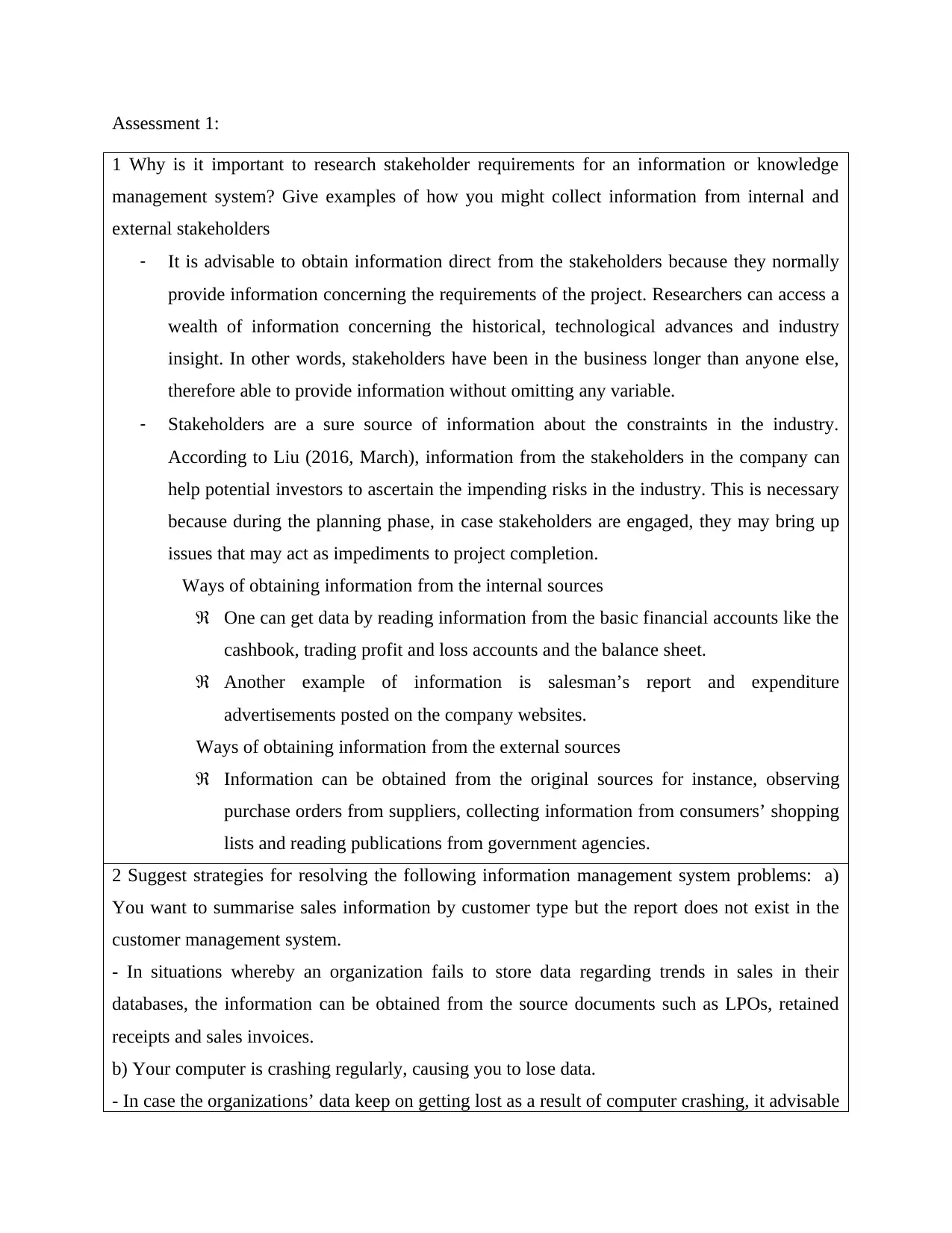
Assessment 1:
1 Why is it important to research stakeholder requirements for an information or knowledge
management system? Give examples of how you might collect information from internal and
external stakeholders
- It is advisable to obtain information direct from the stakeholders because they normally
provide information concerning the requirements of the project. Researchers can access a
wealth of information concerning the historical, technological advances and industry
insight. In other words, stakeholders have been in the business longer than anyone else,
therefore able to provide information without omitting any variable.
- Stakeholders are a sure source of information about the constraints in the industry.
According to Liu (2016, March), information from the stakeholders in the company can
help potential investors to ascertain the impending risks in the industry. This is necessary
because during the planning phase, in case stakeholders are engaged, they may bring up
issues that may act as impediments to project completion.
Ways of obtaining information from the internal sources
One can get data by reading information from the basic financial accounts like the
cashbook, trading profit and loss accounts and the balance sheet.
Another example of information is salesman’s report and expenditure
advertisements posted on the company websites.
Ways of obtaining information from the external sources
Information can be obtained from the original sources for instance, observing
purchase orders from suppliers, collecting information from consumers’ shopping
lists and reading publications from government agencies.
2 Suggest strategies for resolving the following information management system problems: a)
You want to summarise sales information by customer type but the report does not exist in the
customer management system.
- In situations whereby an organization fails to store data regarding trends in sales in their
databases, the information can be obtained from the source documents such as LPOs, retained
receipts and sales invoices.
b) Your computer is crashing regularly, causing you to lose data.
- In case the organizations’ data keep on getting lost as a result of computer crashing, it advisable
1 Why is it important to research stakeholder requirements for an information or knowledge
management system? Give examples of how you might collect information from internal and
external stakeholders
- It is advisable to obtain information direct from the stakeholders because they normally
provide information concerning the requirements of the project. Researchers can access a
wealth of information concerning the historical, technological advances and industry
insight. In other words, stakeholders have been in the business longer than anyone else,
therefore able to provide information without omitting any variable.
- Stakeholders are a sure source of information about the constraints in the industry.
According to Liu (2016, March), information from the stakeholders in the company can
help potential investors to ascertain the impending risks in the industry. This is necessary
because during the planning phase, in case stakeholders are engaged, they may bring up
issues that may act as impediments to project completion.
Ways of obtaining information from the internal sources
One can get data by reading information from the basic financial accounts like the
cashbook, trading profit and loss accounts and the balance sheet.
Another example of information is salesman’s report and expenditure
advertisements posted on the company websites.
Ways of obtaining information from the external sources
Information can be obtained from the original sources for instance, observing
purchase orders from suppliers, collecting information from consumers’ shopping
lists and reading publications from government agencies.
2 Suggest strategies for resolving the following information management system problems: a)
You want to summarise sales information by customer type but the report does not exist in the
customer management system.
- In situations whereby an organization fails to store data regarding trends in sales in their
databases, the information can be obtained from the source documents such as LPOs, retained
receipts and sales invoices.
b) Your computer is crashing regularly, causing you to lose data.
- In case the organizations’ data keep on getting lost as a result of computer crashing, it advisable
Paraphrase This Document
Need a fresh take? Get an instant paraphrase of this document with our AI Paraphraser
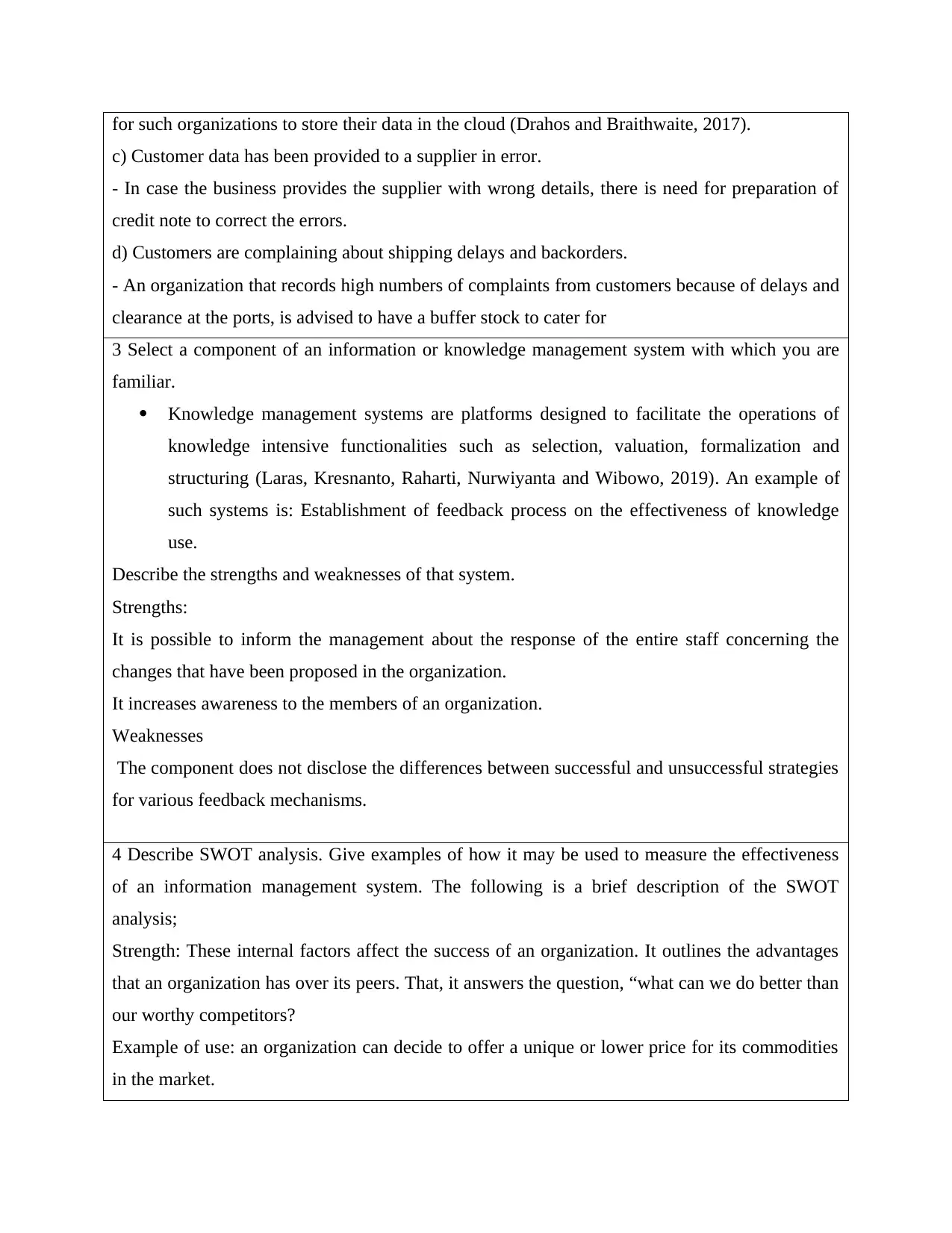
for such organizations to store their data in the cloud (Drahos and Braithwaite, 2017).
c) Customer data has been provided to a supplier in error.
- In case the business provides the supplier with wrong details, there is need for preparation of
credit note to correct the errors.
d) Customers are complaining about shipping delays and backorders.
- An organization that records high numbers of complaints from customers because of delays and
clearance at the ports, is advised to have a buffer stock to cater for
3 Select a component of an information or knowledge management system with which you are
familiar.
Knowledge management systems are platforms designed to facilitate the operations of
knowledge intensive functionalities such as selection, valuation, formalization and
structuring (Laras, Kresnanto, Raharti, Nurwiyanta and Wibowo, 2019). An example of
such systems is: Establishment of feedback process on the effectiveness of knowledge
use.
Describe the strengths and weaknesses of that system.
Strengths:
It is possible to inform the management about the response of the entire staff concerning the
changes that have been proposed in the organization.
It increases awareness to the members of an organization.
Weaknesses
The component does not disclose the differences between successful and unsuccessful strategies
for various feedback mechanisms.
4 Describe SWOT analysis. Give examples of how it may be used to measure the effectiveness
of an information management system. The following is a brief description of the SWOT
analysis;
Strength: These internal factors affect the success of an organization. It outlines the advantages
that an organization has over its peers. That, it answers the question, “what can we do better than
our worthy competitors?
Example of use: an organization can decide to offer a unique or lower price for its commodities
in the market.
c) Customer data has been provided to a supplier in error.
- In case the business provides the supplier with wrong details, there is need for preparation of
credit note to correct the errors.
d) Customers are complaining about shipping delays and backorders.
- An organization that records high numbers of complaints from customers because of delays and
clearance at the ports, is advised to have a buffer stock to cater for
3 Select a component of an information or knowledge management system with which you are
familiar.
Knowledge management systems are platforms designed to facilitate the operations of
knowledge intensive functionalities such as selection, valuation, formalization and
structuring (Laras, Kresnanto, Raharti, Nurwiyanta and Wibowo, 2019). An example of
such systems is: Establishment of feedback process on the effectiveness of knowledge
use.
Describe the strengths and weaknesses of that system.
Strengths:
It is possible to inform the management about the response of the entire staff concerning the
changes that have been proposed in the organization.
It increases awareness to the members of an organization.
Weaknesses
The component does not disclose the differences between successful and unsuccessful strategies
for various feedback mechanisms.
4 Describe SWOT analysis. Give examples of how it may be used to measure the effectiveness
of an information management system. The following is a brief description of the SWOT
analysis;
Strength: These internal factors affect the success of an organization. It outlines the advantages
that an organization has over its peers. That, it answers the question, “what can we do better than
our worthy competitors?
Example of use: an organization can decide to offer a unique or lower price for its commodities
in the market.
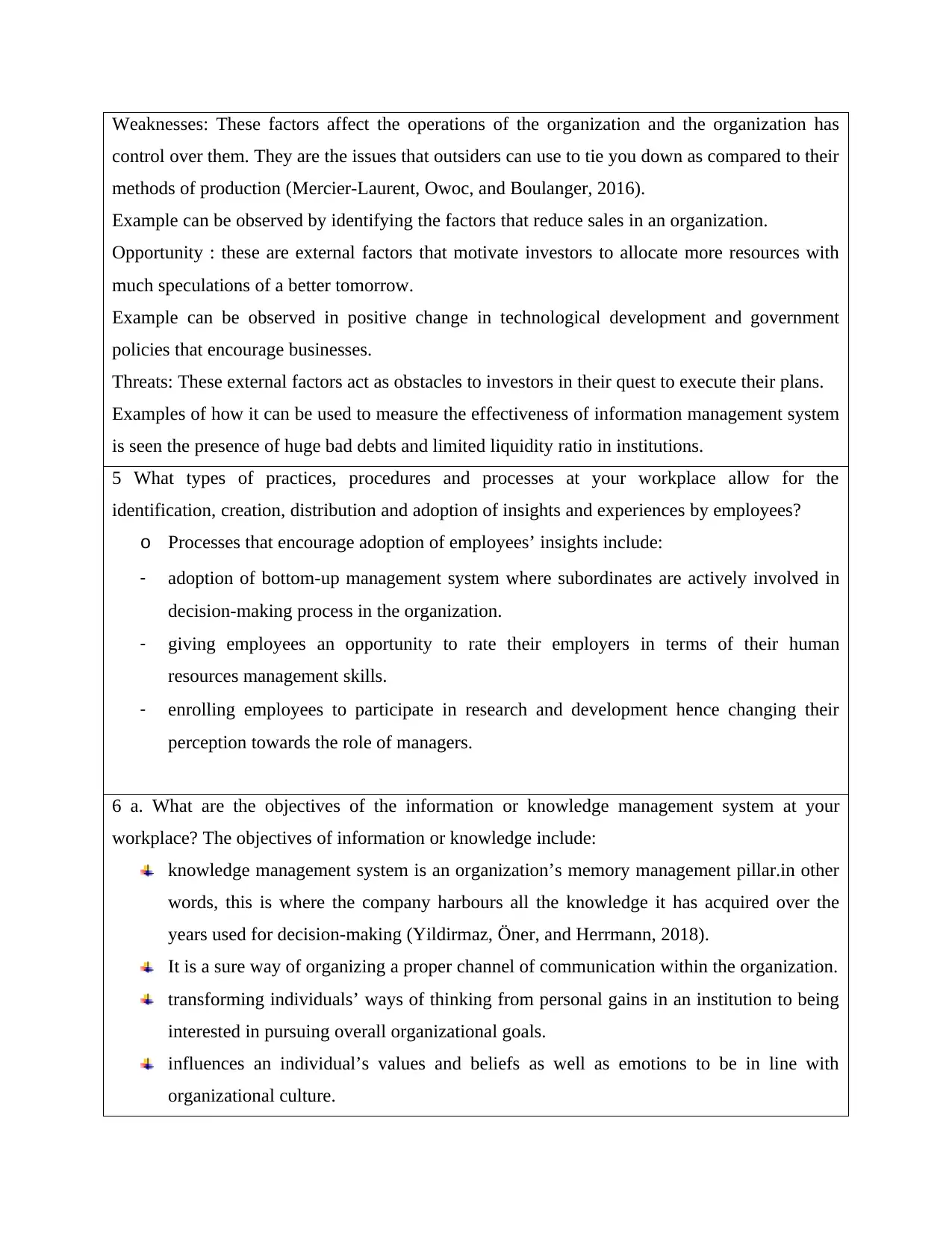
Weaknesses: These factors affect the operations of the organization and the organization has
control over them. They are the issues that outsiders can use to tie you down as compared to their
methods of production (Mercier-Laurent, Owoc, and Boulanger, 2016).
Example can be observed by identifying the factors that reduce sales in an organization.
Opportunity : these are external factors that motivate investors to allocate more resources with
much speculations of a better tomorrow.
Example can be observed in positive change in technological development and government
policies that encourage businesses.
Threats: These external factors act as obstacles to investors in their quest to execute their plans.
Examples of how it can be used to measure the effectiveness of information management system
is seen the presence of huge bad debts and limited liquidity ratio in institutions.
5 What types of practices, procedures and processes at your workplace allow for the
identification, creation, distribution and adoption of insights and experiences by employees?
o Processes that encourage adoption of employees’ insights include:
- adoption of bottom-up management system where subordinates are actively involved in
decision-making process in the organization.
- giving employees an opportunity to rate their employers in terms of their human
resources management skills.
- enrolling employees to participate in research and development hence changing their
perception towards the role of managers.
6 a. What are the objectives of the information or knowledge management system at your
workplace? The objectives of information or knowledge include:
knowledge management system is an organization’s memory management pillar.in other
words, this is where the company harbours all the knowledge it has acquired over the
years used for decision-making (Yildirmaz, Öner, and Herrmann, 2018).
It is a sure way of organizing a proper channel of communication within the organization.
transforming individuals’ ways of thinking from personal gains in an institution to being
interested in pursuing overall organizational goals.
influences an individual’s values and beliefs as well as emotions to be in line with
organizational culture.
control over them. They are the issues that outsiders can use to tie you down as compared to their
methods of production (Mercier-Laurent, Owoc, and Boulanger, 2016).
Example can be observed by identifying the factors that reduce sales in an organization.
Opportunity : these are external factors that motivate investors to allocate more resources with
much speculations of a better tomorrow.
Example can be observed in positive change in technological development and government
policies that encourage businesses.
Threats: These external factors act as obstacles to investors in their quest to execute their plans.
Examples of how it can be used to measure the effectiveness of information management system
is seen the presence of huge bad debts and limited liquidity ratio in institutions.
5 What types of practices, procedures and processes at your workplace allow for the
identification, creation, distribution and adoption of insights and experiences by employees?
o Processes that encourage adoption of employees’ insights include:
- adoption of bottom-up management system where subordinates are actively involved in
decision-making process in the organization.
- giving employees an opportunity to rate their employers in terms of their human
resources management skills.
- enrolling employees to participate in research and development hence changing their
perception towards the role of managers.
6 a. What are the objectives of the information or knowledge management system at your
workplace? The objectives of information or knowledge include:
knowledge management system is an organization’s memory management pillar.in other
words, this is where the company harbours all the knowledge it has acquired over the
years used for decision-making (Yildirmaz, Öner, and Herrmann, 2018).
It is a sure way of organizing a proper channel of communication within the organization.
transforming individuals’ ways of thinking from personal gains in an institution to being
interested in pursuing overall organizational goals.
influences an individual’s values and beliefs as well as emotions to be in line with
organizational culture.
⊘ This is a preview!⊘
Do you want full access?
Subscribe today to unlock all pages.

Trusted by 1+ million students worldwide
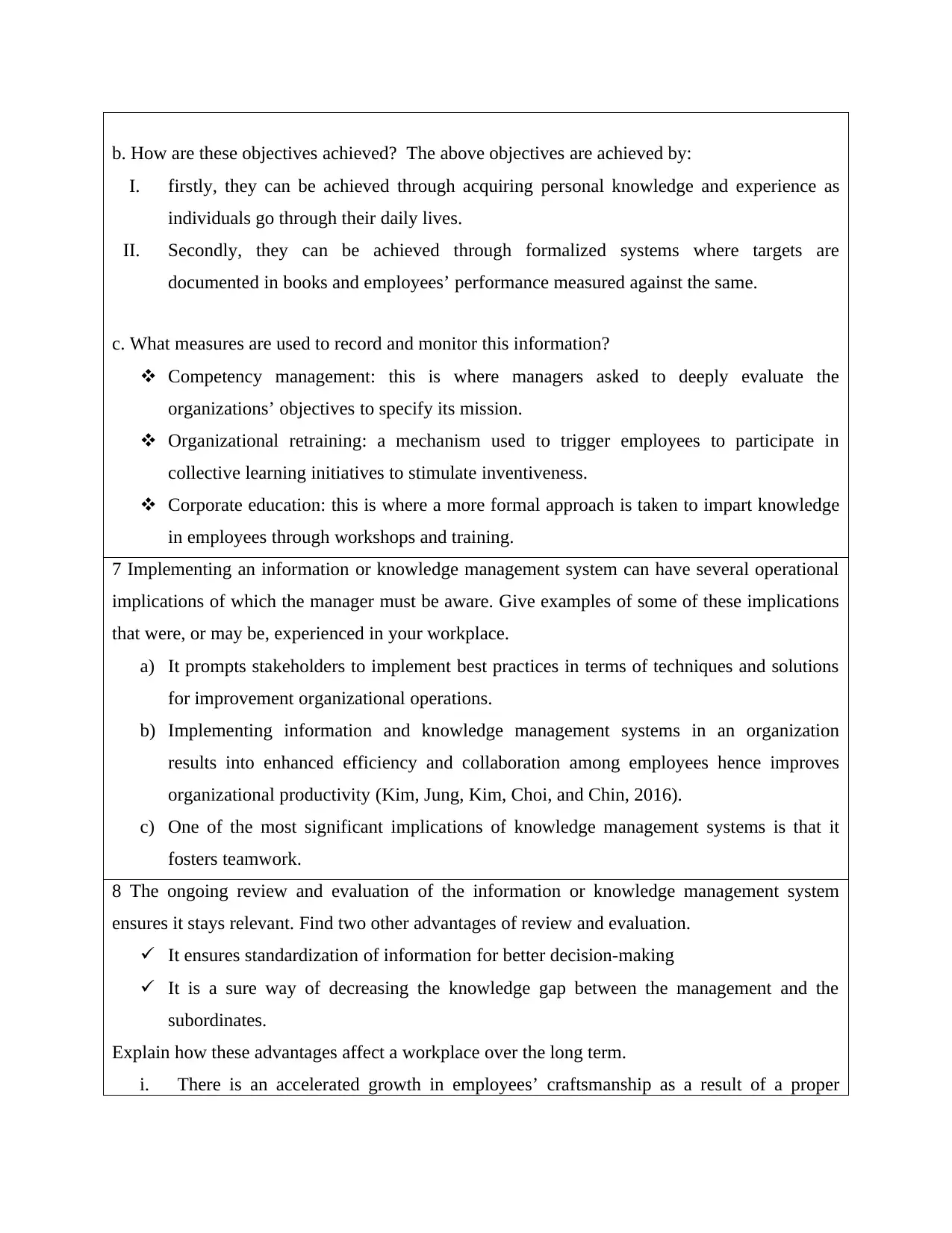
b. How are these objectives achieved? The above objectives are achieved by:
I. firstly, they can be achieved through acquiring personal knowledge and experience as
individuals go through their daily lives.
II. Secondly, they can be achieved through formalized systems where targets are
documented in books and employees’ performance measured against the same.
c. What measures are used to record and monitor this information?
Competency management: this is where managers asked to deeply evaluate the
organizations’ objectives to specify its mission.
Organizational retraining: a mechanism used to trigger employees to participate in
collective learning initiatives to stimulate inventiveness.
Corporate education: this is where a more formal approach is taken to impart knowledge
in employees through workshops and training.
7 Implementing an information or knowledge management system can have several operational
implications of which the manager must be aware. Give examples of some of these implications
that were, or may be, experienced in your workplace.
a) It prompts stakeholders to implement best practices in terms of techniques and solutions
for improvement organizational operations.
b) Implementing information and knowledge management systems in an organization
results into enhanced efficiency and collaboration among employees hence improves
organizational productivity (Kim, Jung, Kim, Choi, and Chin, 2016).
c) One of the most significant implications of knowledge management systems is that it
fosters teamwork.
8 The ongoing review and evaluation of the information or knowledge management system
ensures it stays relevant. Find two other advantages of review and evaluation.
It ensures standardization of information for better decision-making
It is a sure way of decreasing the knowledge gap between the management and the
subordinates.
Explain how these advantages affect a workplace over the long term.
i. There is an accelerated growth in employees’ craftsmanship as a result of a proper
I. firstly, they can be achieved through acquiring personal knowledge and experience as
individuals go through their daily lives.
II. Secondly, they can be achieved through formalized systems where targets are
documented in books and employees’ performance measured against the same.
c. What measures are used to record and monitor this information?
Competency management: this is where managers asked to deeply evaluate the
organizations’ objectives to specify its mission.
Organizational retraining: a mechanism used to trigger employees to participate in
collective learning initiatives to stimulate inventiveness.
Corporate education: this is where a more formal approach is taken to impart knowledge
in employees through workshops and training.
7 Implementing an information or knowledge management system can have several operational
implications of which the manager must be aware. Give examples of some of these implications
that were, or may be, experienced in your workplace.
a) It prompts stakeholders to implement best practices in terms of techniques and solutions
for improvement organizational operations.
b) Implementing information and knowledge management systems in an organization
results into enhanced efficiency and collaboration among employees hence improves
organizational productivity (Kim, Jung, Kim, Choi, and Chin, 2016).
c) One of the most significant implications of knowledge management systems is that it
fosters teamwork.
8 The ongoing review and evaluation of the information or knowledge management system
ensures it stays relevant. Find two other advantages of review and evaluation.
It ensures standardization of information for better decision-making
It is a sure way of decreasing the knowledge gap between the management and the
subordinates.
Explain how these advantages affect a workplace over the long term.
i. There is an accelerated growth in employees’ craftsmanship as a result of a proper
Paraphrase This Document
Need a fresh take? Get an instant paraphrase of this document with our AI Paraphraser
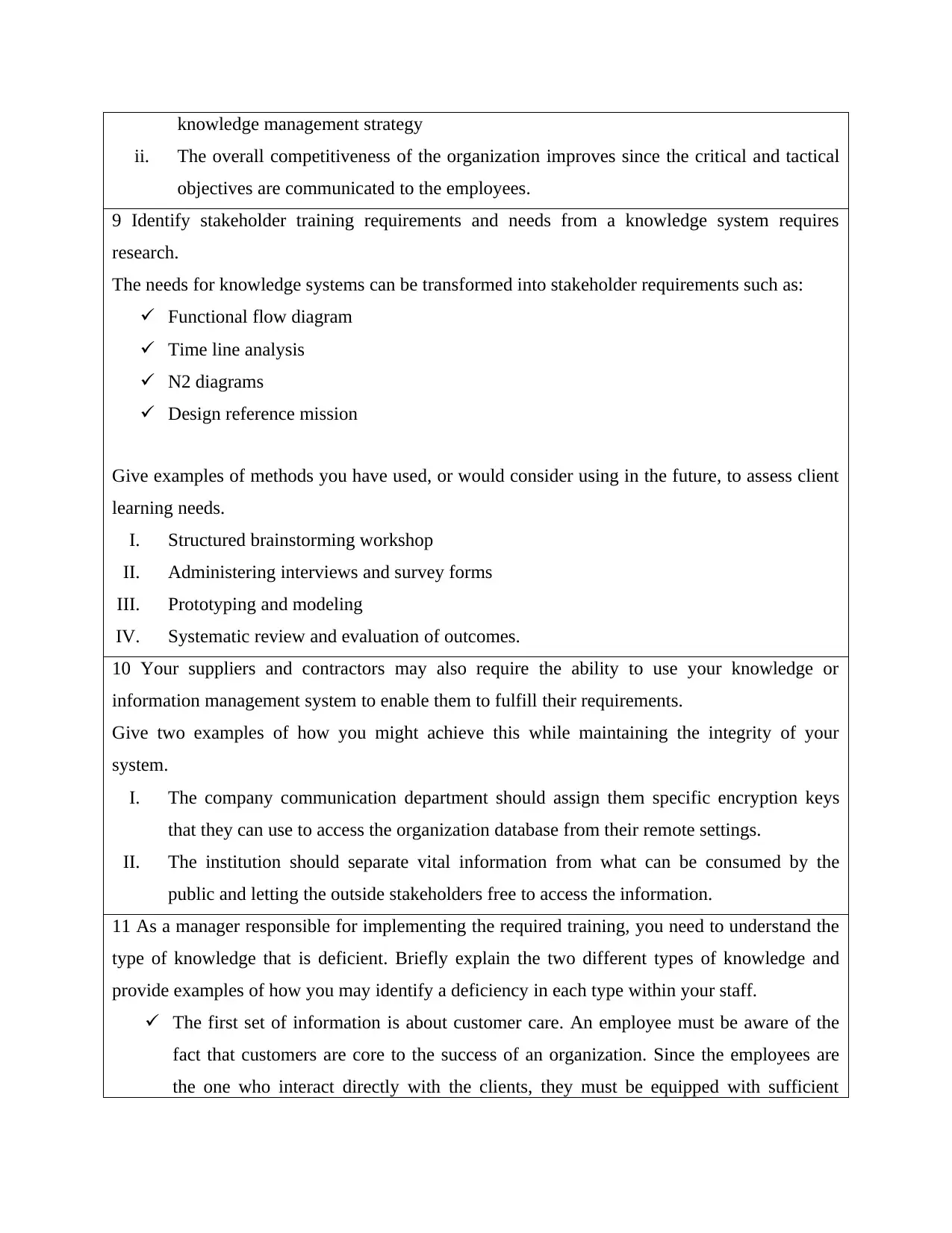
knowledge management strategy
ii. The overall competitiveness of the organization improves since the critical and tactical
objectives are communicated to the employees.
9 Identify stakeholder training requirements and needs from a knowledge system requires
research.
The needs for knowledge systems can be transformed into stakeholder requirements such as:
Functional flow diagram
Time line analysis
N2 diagrams
Design reference mission
Give examples of methods you have used, or would consider using in the future, to assess client
learning needs.
I. Structured brainstorming workshop
II. Administering interviews and survey forms
III. Prototyping and modeling
IV. Systematic review and evaluation of outcomes.
10 Your suppliers and contractors may also require the ability to use your knowledge or
information management system to enable them to fulfill their requirements.
Give two examples of how you might achieve this while maintaining the integrity of your
system.
I. The company communication department should assign them specific encryption keys
that they can use to access the organization database from their remote settings.
II. The institution should separate vital information from what can be consumed by the
public and letting the outside stakeholders free to access the information.
11 As a manager responsible for implementing the required training, you need to understand the
type of knowledge that is deficient. Briefly explain the two different types of knowledge and
provide examples of how you may identify a deficiency in each type within your staff.
The first set of information is about customer care. An employee must be aware of the
fact that customers are core to the success of an organization. Since the employees are
the one who interact directly with the clients, they must be equipped with sufficient
ii. The overall competitiveness of the organization improves since the critical and tactical
objectives are communicated to the employees.
9 Identify stakeholder training requirements and needs from a knowledge system requires
research.
The needs for knowledge systems can be transformed into stakeholder requirements such as:
Functional flow diagram
Time line analysis
N2 diagrams
Design reference mission
Give examples of methods you have used, or would consider using in the future, to assess client
learning needs.
I. Structured brainstorming workshop
II. Administering interviews and survey forms
III. Prototyping and modeling
IV. Systematic review and evaluation of outcomes.
10 Your suppliers and contractors may also require the ability to use your knowledge or
information management system to enable them to fulfill their requirements.
Give two examples of how you might achieve this while maintaining the integrity of your
system.
I. The company communication department should assign them specific encryption keys
that they can use to access the organization database from their remote settings.
II. The institution should separate vital information from what can be consumed by the
public and letting the outside stakeholders free to access the information.
11 As a manager responsible for implementing the required training, you need to understand the
type of knowledge that is deficient. Briefly explain the two different types of knowledge and
provide examples of how you may identify a deficiency in each type within your staff.
The first set of information is about customer care. An employee must be aware of the
fact that customers are core to the success of an organization. Since the employees are
the one who interact directly with the clients, they must be equipped with sufficient
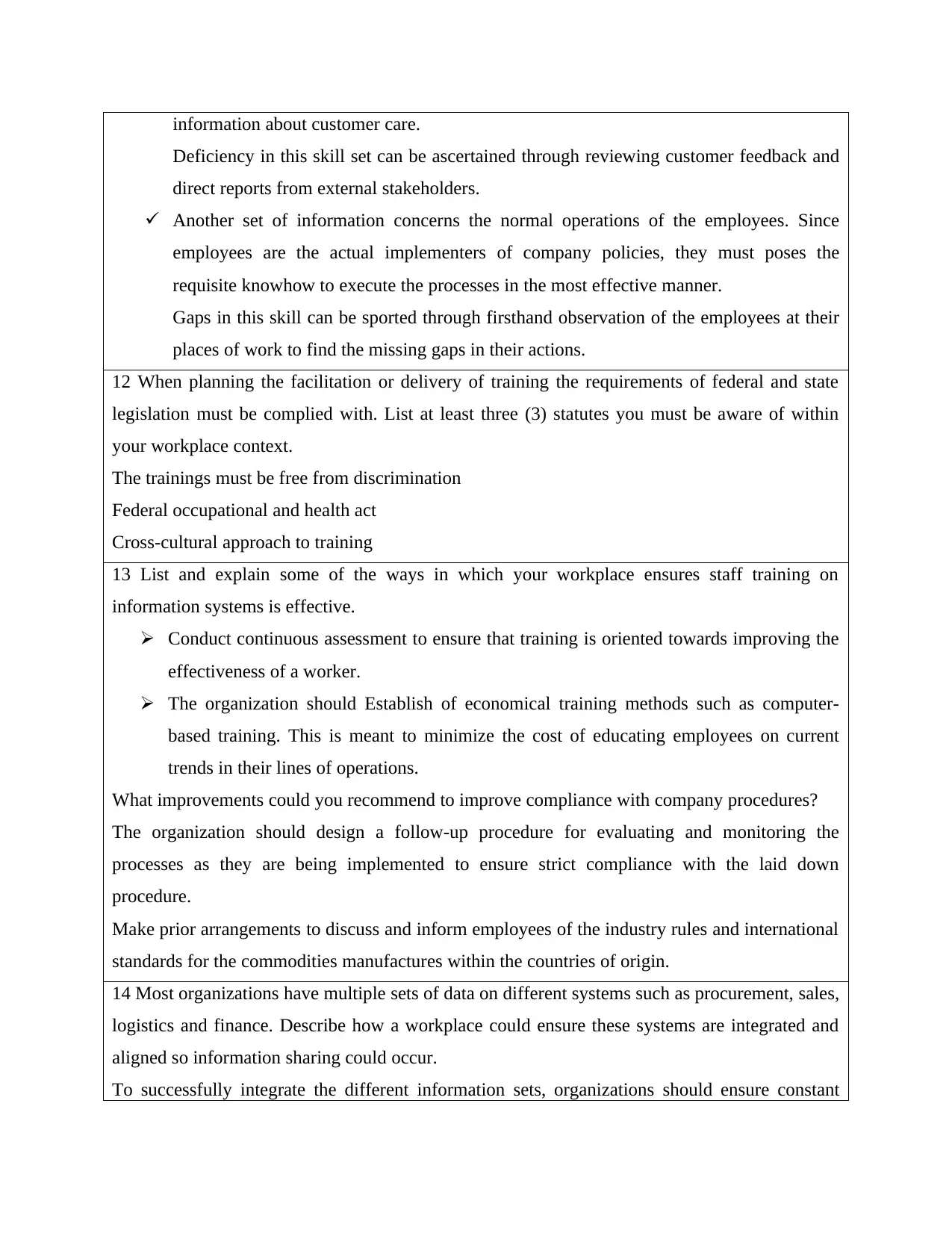
information about customer care.
Deficiency in this skill set can be ascertained through reviewing customer feedback and
direct reports from external stakeholders.
Another set of information concerns the normal operations of the employees. Since
employees are the actual implementers of company policies, they must poses the
requisite knowhow to execute the processes in the most effective manner.
Gaps in this skill can be sported through firsthand observation of the employees at their
places of work to find the missing gaps in their actions.
12 When planning the facilitation or delivery of training the requirements of federal and state
legislation must be complied with. List at least three (3) statutes you must be aware of within
your workplace context.
The trainings must be free from discrimination
Federal occupational and health act
Cross-cultural approach to training
13 List and explain some of the ways in which your workplace ensures staff training on
information systems is effective.
Conduct continuous assessment to ensure that training is oriented towards improving the
effectiveness of a worker.
The organization should Establish of economical training methods such as computer-
based training. This is meant to minimize the cost of educating employees on current
trends in their lines of operations.
What improvements could you recommend to improve compliance with company procedures?
The organization should design a follow-up procedure for evaluating and monitoring the
processes as they are being implemented to ensure strict compliance with the laid down
procedure.
Make prior arrangements to discuss and inform employees of the industry rules and international
standards for the commodities manufactures within the countries of origin.
14 Most organizations have multiple sets of data on different systems such as procurement, sales,
logistics and finance. Describe how a workplace could ensure these systems are integrated and
aligned so information sharing could occur.
To successfully integrate the different information sets, organizations should ensure constant
Deficiency in this skill set can be ascertained through reviewing customer feedback and
direct reports from external stakeholders.
Another set of information concerns the normal operations of the employees. Since
employees are the actual implementers of company policies, they must poses the
requisite knowhow to execute the processes in the most effective manner.
Gaps in this skill can be sported through firsthand observation of the employees at their
places of work to find the missing gaps in their actions.
12 When planning the facilitation or delivery of training the requirements of federal and state
legislation must be complied with. List at least three (3) statutes you must be aware of within
your workplace context.
The trainings must be free from discrimination
Federal occupational and health act
Cross-cultural approach to training
13 List and explain some of the ways in which your workplace ensures staff training on
information systems is effective.
Conduct continuous assessment to ensure that training is oriented towards improving the
effectiveness of a worker.
The organization should Establish of economical training methods such as computer-
based training. This is meant to minimize the cost of educating employees on current
trends in their lines of operations.
What improvements could you recommend to improve compliance with company procedures?
The organization should design a follow-up procedure for evaluating and monitoring the
processes as they are being implemented to ensure strict compliance with the laid down
procedure.
Make prior arrangements to discuss and inform employees of the industry rules and international
standards for the commodities manufactures within the countries of origin.
14 Most organizations have multiple sets of data on different systems such as procurement, sales,
logistics and finance. Describe how a workplace could ensure these systems are integrated and
aligned so information sharing could occur.
To successfully integrate the different information sets, organizations should ensure constant
⊘ This is a preview!⊘
Do you want full access?
Subscribe today to unlock all pages.

Trusted by 1+ million students worldwide
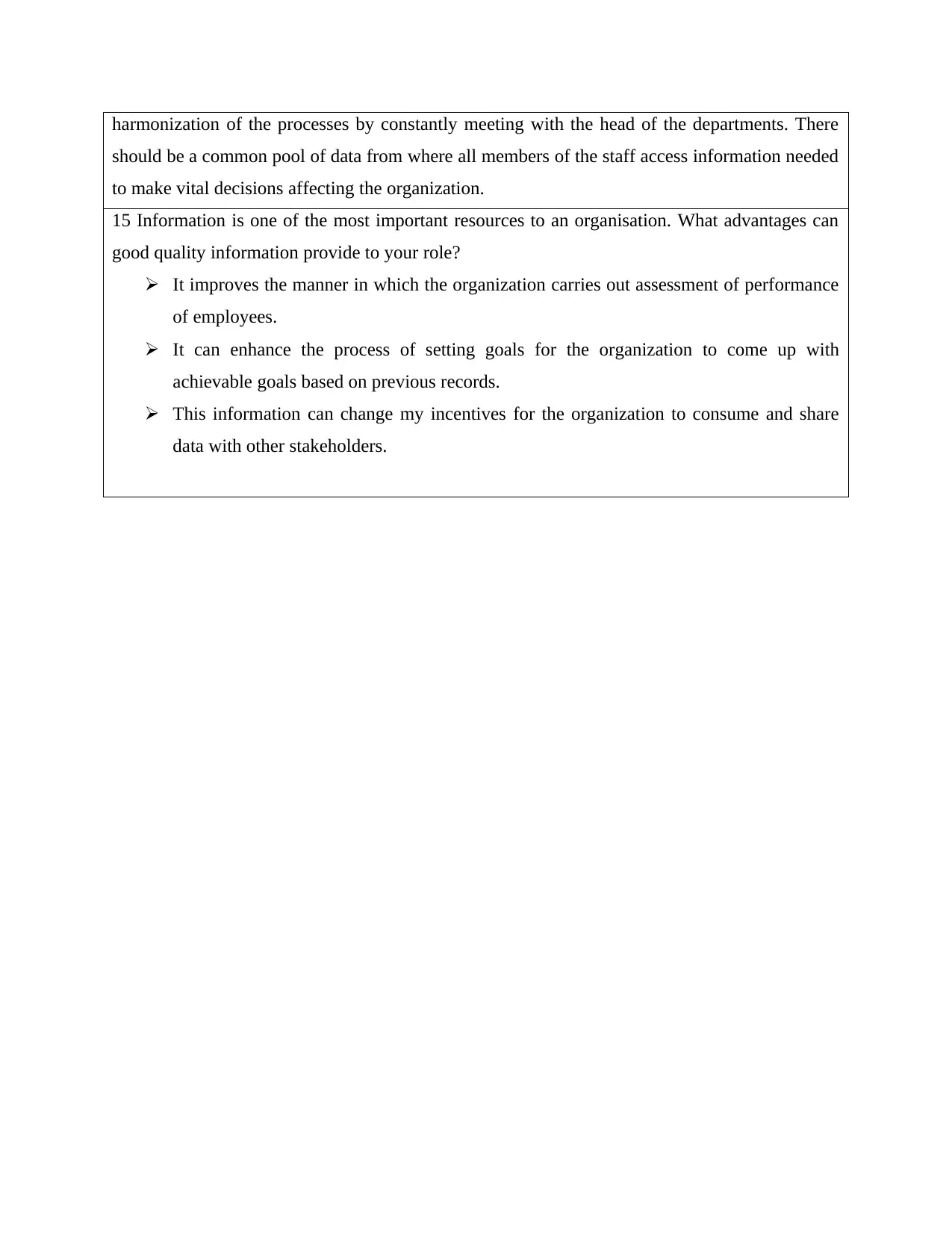
harmonization of the processes by constantly meeting with the head of the departments. There
should be a common pool of data from where all members of the staff access information needed
to make vital decisions affecting the organization.
15 Information is one of the most important resources to an organisation. What advantages can
good quality information provide to your role?
It improves the manner in which the organization carries out assessment of performance
of employees.
It can enhance the process of setting goals for the organization to come up with
achievable goals based on previous records.
This information can change my incentives for the organization to consume and share
data with other stakeholders.
should be a common pool of data from where all members of the staff access information needed
to make vital decisions affecting the organization.
15 Information is one of the most important resources to an organisation. What advantages can
good quality information provide to your role?
It improves the manner in which the organization carries out assessment of performance
of employees.
It can enhance the process of setting goals for the organization to come up with
achievable goals based on previous records.
This information can change my incentives for the organization to consume and share
data with other stakeholders.
Paraphrase This Document
Need a fresh take? Get an instant paraphrase of this document with our AI Paraphraser
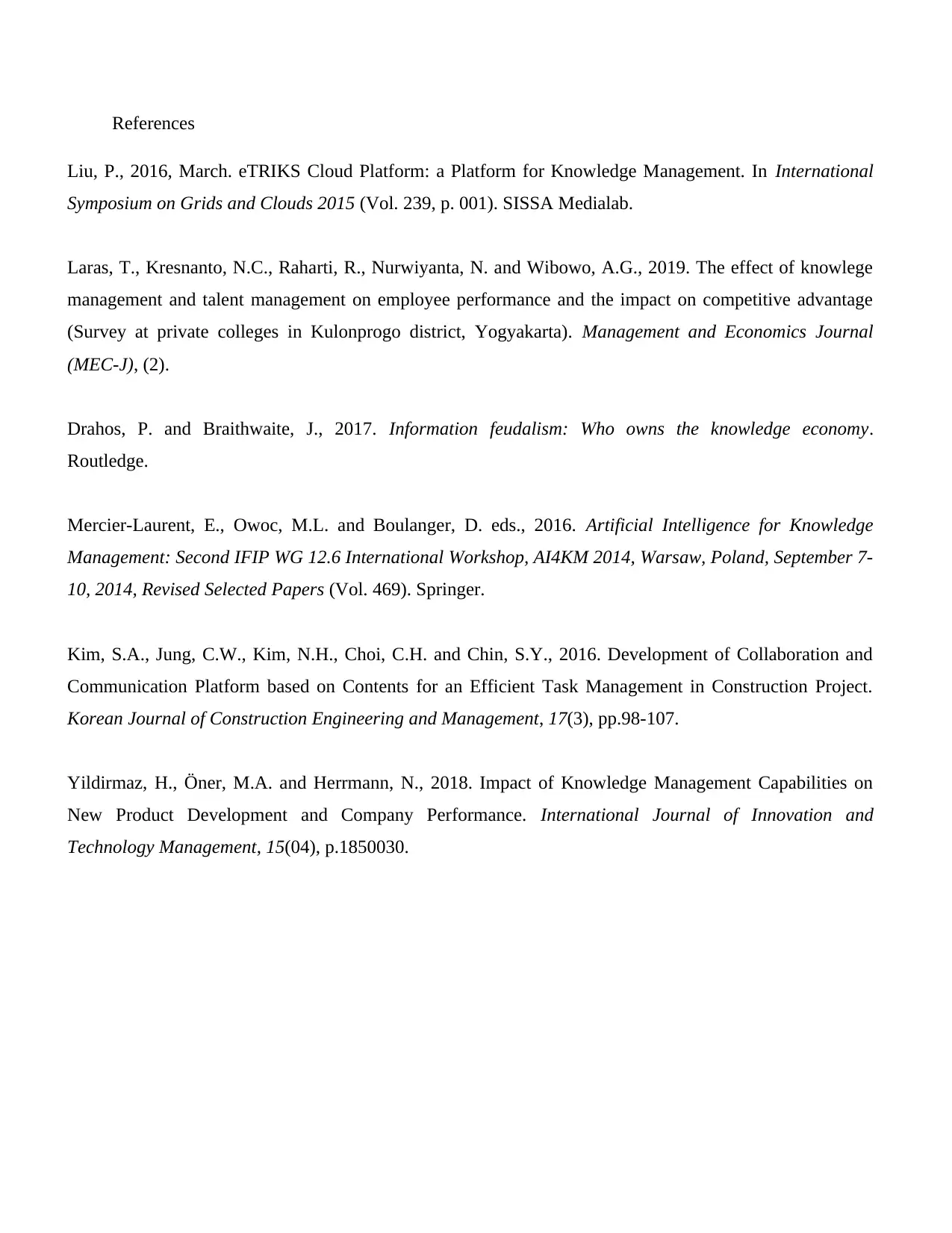
References
Liu, P., 2016, March. eTRIKS Cloud Platform: a Platform for Knowledge Management. In International
Symposium on Grids and Clouds 2015 (Vol. 239, p. 001). SISSA Medialab.
Laras, T., Kresnanto, N.C., Raharti, R., Nurwiyanta, N. and Wibowo, A.G., 2019. The effect of knowlege
management and talent management on employee performance and the impact on competitive advantage
(Survey at private colleges in Kulonprogo district, Yogyakarta). Management and Economics Journal
(MEC-J), (2).
Drahos, P. and Braithwaite, J., 2017. Information feudalism: Who owns the knowledge economy.
Routledge.
Mercier-Laurent, E., Owoc, M.L. and Boulanger, D. eds., 2016. Artificial Intelligence for Knowledge
Management: Second IFIP WG 12.6 International Workshop, AI4KM 2014, Warsaw, Poland, September 7-
10, 2014, Revised Selected Papers (Vol. 469). Springer.
Kim, S.A., Jung, C.W., Kim, N.H., Choi, C.H. and Chin, S.Y., 2016. Development of Collaboration and
Communication Platform based on Contents for an Efficient Task Management in Construction Project.
Korean Journal of Construction Engineering and Management, 17(3), pp.98-107.
Yildirmaz, H., Öner, M.A. and Herrmann, N., 2018. Impact of Knowledge Management Capabilities on
New Product Development and Company Performance. International Journal of Innovation and
Technology Management, 15(04), p.1850030.
Liu, P., 2016, March. eTRIKS Cloud Platform: a Platform for Knowledge Management. In International
Symposium on Grids and Clouds 2015 (Vol. 239, p. 001). SISSA Medialab.
Laras, T., Kresnanto, N.C., Raharti, R., Nurwiyanta, N. and Wibowo, A.G., 2019. The effect of knowlege
management and talent management on employee performance and the impact on competitive advantage
(Survey at private colleges in Kulonprogo district, Yogyakarta). Management and Economics Journal
(MEC-J), (2).
Drahos, P. and Braithwaite, J., 2017. Information feudalism: Who owns the knowledge economy.
Routledge.
Mercier-Laurent, E., Owoc, M.L. and Boulanger, D. eds., 2016. Artificial Intelligence for Knowledge
Management: Second IFIP WG 12.6 International Workshop, AI4KM 2014, Warsaw, Poland, September 7-
10, 2014, Revised Selected Papers (Vol. 469). Springer.
Kim, S.A., Jung, C.W., Kim, N.H., Choi, C.H. and Chin, S.Y., 2016. Development of Collaboration and
Communication Platform based on Contents for an Efficient Task Management in Construction Project.
Korean Journal of Construction Engineering and Management, 17(3), pp.98-107.
Yildirmaz, H., Öner, M.A. and Herrmann, N., 2018. Impact of Knowledge Management Capabilities on
New Product Development and Company Performance. International Journal of Innovation and
Technology Management, 15(04), p.1850030.
1 out of 8
Related Documents
Your All-in-One AI-Powered Toolkit for Academic Success.
+13062052269
info@desklib.com
Available 24*7 on WhatsApp / Email
![[object Object]](/_next/static/media/star-bottom.7253800d.svg)
Unlock your academic potential
Copyright © 2020–2025 A2Z Services. All Rights Reserved. Developed and managed by ZUCOL.

![Business Information Management (BIM) Assessment - [University Name]](/_next/image/?url=https%3A%2F%2Fdesklib.com%2Fmedia%2Fimages%2Fid%2F5e7f697d903242a39be138e448f53c89.jpg&w=256&q=75)



